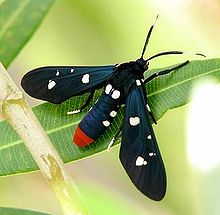- Syntomeida epilais
-
Polka-Dot Wasp Moth 
Scientific classification Kingdom: Animalia Phylum: Arthropoda Class: Insecta Order: Lepidoptera Family: Arctiidae Tribe: Euchromiini Genus: Syntomeida Species: S. epilais Binomial name Syntomeida epilais
Walker, 1854The Polka-Dot Wasp Moth (Syntomeida epilais) is a species of moth thought to be native to the Caribbean.[1] The species is also called the Oleander Moth after the Oleander plant, from which its young feed. Like most wasp moths, these moths are day fliers.[2]
And they prefer neotropic areas, to which they are native. The North American subspecies is S. epilais jucundissima, which is locally common in all areas of Florida, and has been seen as far north as Savannah, GA.[2]
Contents
Description
They are dark metallic blue with a couple of white polka-dots dotting the wings and upper abdomen. The tip of the moth's abdomen is bright red; it looks like a very dangerous wasp, but in fact is a harmless moth.The caterpillars are orange or dark orange with long black hairs. The caterpillars look dangerous, but the setae do not inflict any harm.[1][2]
Reproduction and breeding
Females contact male polka-dot wasp moths by means of ultrasonic signals. On the branch, the sound travels, and then the male follows the sound to his new mate. When he reaches her, he emits an answering signal.
Pest
The larvae stage of the Polka-Dot wasp moth, commonly called the Oleander caterpillar, is widely known for its gluttonous appetite. The caterpillar feeds in almost any location (excepting California) where its food, the Oleander plant, can be found. They are gregarious and can cause damage from minor to severe. It may also feed on devil's potato plants, which are believed to be its native food before the Oleander plant was introduced to the Americas by Spanish settlers in the seventeenth century.[1]
See also
- Oleander
- Euchromiini
References
- ^ a b c Vandaveer, Chelsie; none (October 8, 2003). "What is the polka-dot wasp moth? - Renfield's Garden". Renfield's Garden Archive. © 2001 - 2009 C. Vandaveer & Killerplants.com. pp. 1 of 5. http://www.killerplants.com/renfields-garden/20031008.asp. Retrieved 2009-07-03.
- ^ a b c "Species Detail". Butterflies and Moths of North America. Big Sky Institute at Montana State University. pp. 1. http://www.butterfliesandmoths.org/species?l=3869. Retrieved 2009-07-03.
External links
Categories:
Wikimedia Foundation. 2010.


